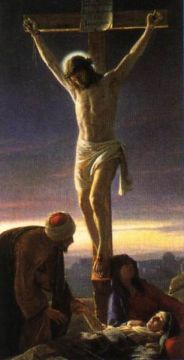|
|
| Musical Musings: Lent |
Page 2 |
 |
 |
Questions & Answers: The Cross (Cont.)
- Match the crosses below with their descriptions.
- Papal cross
- Patriarchal cross
- Pectoral cross
- Processional cross
- a. A cross with two crossbars, of which the upper is shorter, usually carried before an archbishop in processions in his own province
- b. A crucifix mounted on long shafts of metal or wood and carried aloft at the head of processions
- c. A cross carried before a pope, with three transverse bars of varying length, the smallest at the top
- d. A cross worn on the breast by a bishop, suspended from a cord or chain and worn outside the clothing, usually of gold and containing relics
1. c 2. a 3. d 4. b
- Why do we make the Sign of the Cross?
This sacramental expresses our faith both in the redemption of Christ and the Trinity.
This practice has been used since the earliest Christian times and was often mentioned by Saint Augustine.
Originally, the Sign of the Cross was made with three fingers, signifying the Trinity, on the forehead only, instead of the form in common use today.

- Where do we get the devotion called the Stations of the Cross?
This popular devotion originated in the time of the Crusades when the knights and pilgrims in Jerusalem began to follow the route of Christ's way to Calvary in prayerful meditation, according to the ancient practice of pilgrims.
The devotion spread throughout Europe and developed into its present form through the zealous efforts of Franciscan friars in the 14th and 15th centuries.
Although today we generally use 14 stations, or stops for meditation, originally the number of stations varied.
- What does a red cross stand for?
Nearly 300 years before the foundation of the international Red Cross, a red cross had already become a symbol of organized charity and dedication to the sick.
Saint Camillus de Lellis, founder of the Ministers of the Sick, sewed a red cross to the habits of the order to remind the priests and brothers of the basis on their commitment to the sick and to serve as an inspiration to the sick by reminding them of the passion, death and resurrection of Our Lord.
- Why is the Byzantine cross at San Damiano famous?
It was before this painted image of the crucifix that Saint Francis of Assisi was praying when the crucified Christ seemed to speak to him, telling him to go and repair the Church.
- How does the cross itself have a cosmic significance?
From the time of pagan antiquity, the cross evoked the whole universe with its four cardinal points reaching out to embrace all creation.
Jesus alluded to this when He said, "And when I am lifted up from the earth, I will draw everyone to myself" (Jn 12:32).
- What do the letters I.N.R.I., usually found above the image on a crucifix, stand for?
These are the first letters of the Latin title written by Pilate: Iesus Nazarænus Rex Iudæorum or "Jesus of Nazareth, King of the Jews."
- How is Calvary linked to Eden through the cross?
Just as Adam and Eve fell and "lost life" by eating the fruit from the forbidden tree (see Gen 3:3), so Christ gives "new life" to men through his death on the wood of the cross.
In medieval stained glass, the cross was often colored green to remind people that the New Adam overturned the sin of the old Adam.
- What is the oldest-known depiction of the Crucifixion?
A graffito (wall drawing) that represents a crucified figure with a donkey's head has been found on the Palatine Hill in Rome.
An early non-Christian scribbled this crude drawing to mock believers and scrawled a ridiculing statement in Latin, which translated says: "Alexamenos worships his god."
- How did the Jews and pagans react to Jesus' self-sacrificing death by crucifixion?
They were horrified.
In antiquity, the crucified Christ was an embarrassment, whose punishment was degrading and even perverse.
That's why Saint Paul so vigorously preached the "newness" of Christianity: "We proclaim Christ crucified, a stumbling block to Jews and foolishness to Gentiles" (I Cor 1:23).
- What paradox does the cross itself express?
It is both a sign of the power of evil — Jesus' planned torture and death — as well as of divine love: Jesus "humbled himself, becoming obedient to death, even death on a cross" (Phil 2:8).
The cross recalls sin and degradation as well as love and redemption.
- Why should Catholics wear crucifixes and have them in their homes and places of work?
The cross reminds us that God has saved us in this way: "For in him [Christ] all the fullness of God was pleased to dwell, and through him to reconcile to himself all things, whether on earth or in heaven, making peace by the blood of his cross" (Col 1:19-20).
It helps us understand the true meaning of self-sacrificing love and to endure suffering in union with Christ.
- Why does the deacon or priest make the Sign of the Cross on his forehead, mouth and chest before reading the Gospel at Mass?
This is a medieval gesture that expresses the desire to open one's mind to the Word of God, to speak the Good News, and to hold it lovingly in one's heart.
|
|



